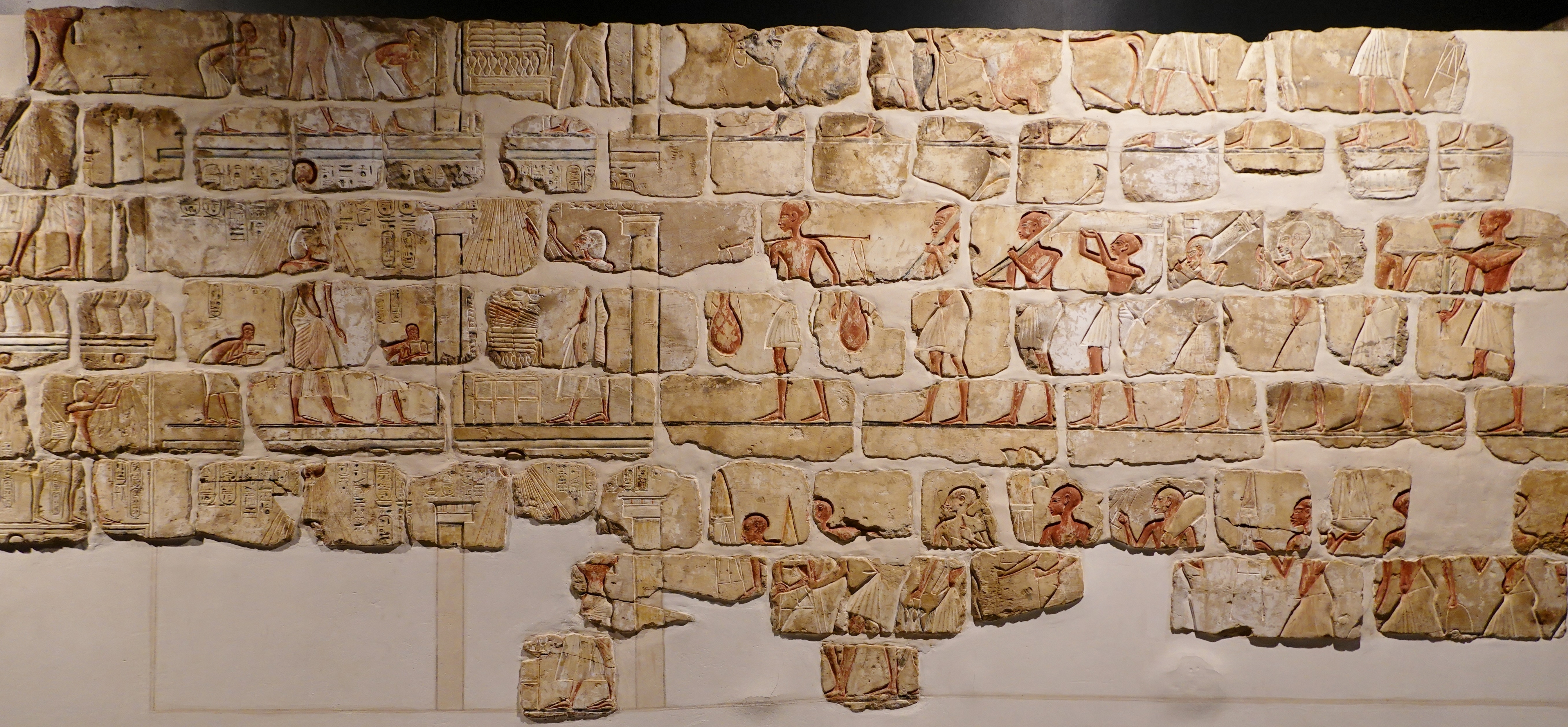talatat on:
[Wikipedia]
[Google]
[Amazon]
 Talatat are
Talatat are
Talatat wall Scene
www.usu.edu
Akhenaten worshipping scene: Talatat
euler.sle.edu Egyptian artefact types Building stone
 Talatat are
Talatat are limestone
Limestone ( calcium carbonate ) is a type of carbonate sedimentary rock which is the main source of the material lime. It is composed mostly of the minerals calcite and aragonite, which are different crystal forms of . Limestone forms when ...
blocks of standardized size (c. 27 by 27 by 54 cm, corresponding to by by 1 ancient Egyptian cubits) used during the 18th Dynasty reign of the Pharaoh Akhenaten
Akhenaten (pronounced ), also spelled Echnaton, Akhenaton, ( egy, ꜣḫ-n-jtn ''ʾŪḫə-nə-yātəy'', , meaning "Effective for the Aten"), was an ancient Egyptian pharaoh reigning or 1351–1334 BC, the tenth ruler of the Eighteenth D ...
in the building of the Aton temples at Karnak
The Karnak Temple Complex, commonly known as Karnak (, which was originally derived from ar, خورنق ''Khurnaq'' "fortified village"), comprises a vast mix of decayed temples, pylons, chapels, and other buildings near Luxor, Egypt. Construc ...
and Akhetaten (modern Amarna
Amarna (; ar, العمارنة, al-ʿamārnah) is an extensive Egyptian archaeological site containing the remains of what was the capital city of the late Eighteenth Dynasty. The city was established in 1346 BC, built at the direction of the ...
). The standardized size and their small weight made construction more efficient. Their use may have begun in the second year of Akhenaten's reign. After the Amarna Period talatat construction was abandoned, apparently not having withstood the test of time.
Amenhotep IV talatats
The blocks used in theTemple of Amenhotep IV The Temple of Amenhotep IV was an ancient monument at Karnak in Luxor, Egypt. The structures were used during the New Kingdom, in the first four years of the 18th Dynasty reign of the Egyptian Pharaoh Akhenaten, when he still used the name Amenhote ...
in Karnak, and the other abandoned temples devoted to the deity Aten
Aten also Aton, Atonu, or Itn ( egy, jtn, ''reconstructed'' ) was the focus of Atenism, the religious system established in ancient Egypt by the Eighteenth Dynasty pharaoh Akhenaten. The Aten was the disc of the sun and originally an aspect ...
, were reused by Horemheb
Horemheb, also spelled Horemhab or Haremhab ( egy, ḥr-m-ḥb, meaning "Horus is in Jubilation") was the last pharaoh of the 18th Dynasty of Egypt (1550–1295 BC). He ruled for at least 14 years between 1319 BC and 1292 BC. ...
and Ramesses II
Ramesses II ( egy, rꜥ-ms-sw ''Rīʿa-məsī-sū'', , meaning "Ra is the one who bore him"; ), commonly known as Ramesses the Great, was the third pharaoh of the Nineteenth Dynasty of Egypt. Along with Thutmose III he is often regarded as t ...
as filler material for pylons and as foundations for large buildings. The Great Hypostyle Hall
The Great Hypostyle Hall is located within the Karnak temple complex, in the Precinct of Amon-Re. It is one of the most visited monuments of Ancient Egypt. The structure was built around the 19th Egyptian Dynasty (c. 1290–1224 BC). Its design ...
at Karnak is built on thousands of these blocks, as is the Second Pylon.
Tens of thousands of the talatat have been recovered. The decorated stones are being photographed and the scenes they depict are reconstructed as part of the Akhenaten Temple Project.
Etymology
The term ''talatat'' was apparently used by the Egyptian workmen and introduced into the language of archaeology by the Egyptologist H. Chevrier. There are two hypotheses as to the word's generally unknown ultimate origin in reference to the stones, perhaps not contradictory: The word may be derived from Italian ''tagliata'', meaning cut masonry. Or, derived from theEgyptian Arabic
Egyptian Arabic, locally known as Colloquial Egyptian ( ar, العامية المصرية, ), or simply Masri (also Masry) (), is the most widely spoken vernacular Arabic dialect in Egypt. It is part of the Afro-Asiatic language family, and ...
word تلاتة (talāta, 'three'), indicating that each block is three hand-spans long.
References
Bibliography
* * * * *External links
{{Commons category, TalatatsTalatat wall Scene
www.usu.edu
Akhenaten worshipping scene: Talatat
euler.sle.edu Egyptian artefact types Building stone